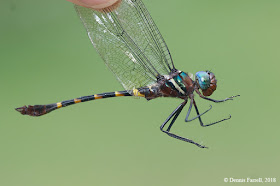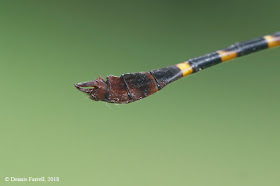Number: 214
Family: Libellulidae
Genus: Lyriothemis
Species: Lyriothemis sp. (possibly yet to be described)
Common Name(s): N/A
Habitat: Open wasteland/scrub
Provinces sighted: Chantaburi environs
Sightings (by me): Abundant (males and females) at one location
In flight: July
Species easily confused with: Lyriothemis elegantissima, Lyriothemis sp.
Right at the end of the last day, there was one last location to visit before heading home. Again, we were lead to the location by a fellow dragonfly hunter on Dragonflies of Thailand (Facebook Group). And, yet again, sadly I don't remember their name... but a million thanks anyway! Once we arrived, I was a little shocked. Just like the farmer's paddy field where there were numerous Mortonagrion falactum, this was just a simple field. Seriously, come one. There are millions like it it Khon Kaen. Boring, featureless fields. No way can a rare species reside there. It was a big field, granted, with a lot of long grass. But just a field like any other all the same. However, a female Lyriothemis species had been spotted there and it looked incredibly like L. pachygastra, the male of which I am desperate to see with its awesome blue markings. But I was not confident of seeing anything here. Not a chance. Anyway, there was lots of broken glass in the field and while some of the others put on more suitable footwear, I dived in... within about 5 seconds I came across a female. Amazing! Then a male. Then two more. In fact, they were everywhere! Loads of Lyriothemis out in the open. Why? How? Who? What? What was going on? Who knows? But, there they were, as happy as anything. Within a very short space of time and with everyone well and truly sated with their shots, it was apparent that it wasn't L. pachygastra. It was something else. L. elegantissima was mentioned as was the species I had seen in Phu Khieo, though I wasn't entirely convinced. Upon returning home (and others also collected a few specimens), I began to compare my photos with the ones from PK. The genitalia was slightly different and there were a few other subtle differences. I am convinced it is NOT that species. Then, upon finding Tom's blog (as usual hehe) I notice that he had already posted wonderful photos of L. elegantissima.. it was very similar and found in a similar habitat but, most importantly, the genitalia is almost identical. So, L. elegantissima it was, yay!... though Noppadon still had his doubts ( he always does, haha).
Well, not quite. A week later, I returned to PK to find the first Lyriothemis species I found a few years back. They were usually fairly easy to find at this time of year. Amazingly, however, there were none... as was the same with many species. Bad year, bad timing, poor weather (it was dull and had been all week). I go for the latter and will return tomorrow as of writing this blog. However, due to their absence at the very death of a long and tough day, I noticed a largish dragon in the tree branches. I thought it was simply O. chrysis at first (forgive me but I need glasses and it was seriously dull!) but it didn't seem to sit right. So, I moved in a little and there it was... Lyriothemis elegantissima, known from Khao Yai... This was clearly the true form (prominent black markings -- see post 215 when I have actually posted it) and was in the habitat where I would expect to find it... dull and swampy. So, though very happy to see the true L. elegantissima for the first time and a first for PK, it has relegated this species from Chantaburi back to Lyriothemis sp.... roll on someone describing it!
The Male
Very similar to other red Lyriothemis species but the genitalia and markings are slightly different.
The Female
It is similar to the male but more yellowish in colour, though a few of us saw an orangish female.
A slightly older female...
... and a fully matured female?
...and a young female from a different angle...
Mr and Mrs Lyriothemis... something I saw a few times... the male with the female but not copulating. I wonder why? Copulated already and the male is protecting her? She isn't ready and he is waiting? They are just friends?




























